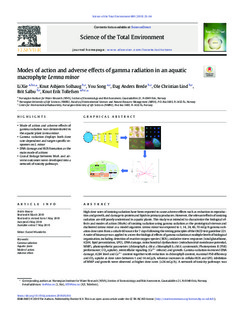| dc.description.abstract | High dose rates of ionizing radiation have been reported to cause adverse effects such as reduction in reproduction and growth, and damage to protein and lipids in primary producers. However, the relevant effects of ionizing radiation are still poorly understood in aquatic plants. This study was intended to characterize the biological effects and modes of action (MoAs) of ionizing radiation using gamma radiation as the prototypical stressor and duckweed Lemna minor as a model organism. Lemna minor was exposed to 1, 14, 24, 46, 70 mGy/h gamma radiation dose rates from a cobalt-60 source for 7 days following the testing principles of the OECD test guideline 221. A suite of bioassays was applied to assess the biological effects of gamma radiation at multiple levels of biological organization, including detection of reactive oxygen species (ROS), oxidative stress responses (total glutathione, tGSH; lipid peroxidation, LPO), DNA damage, mitochondrial dysfunctions (mitochondrial membrane potential, MMP), photosynthetic parameters (chlorophyll a, chl a; chlorophyll b, chl b; carotenoids; Photosystem II (PSII) performance; CO2 uptake), intercellular signaling (Ca2+ release) and growth. Gamma radiation increased DNA damage, tGSH level and Ca2+ content together with reduction in chlorophyll content, maximal PSII efficiency and CO2 uptake at dose rates between 1 and 14 mGy/h, whereas increases in cellular ROS and LPO, inhibition of MMP and growth were observed at higher dose rates (≥24 mGy/h). A network of toxicity pathways was proposed to portray the causal relationships between gamma radiation-induced physiological responses and adverse outcomes to support the development of Adverse Outcome Pathways (AOPs) for ionizing radiation-mediated effects in primary producers. | nb_NO |

